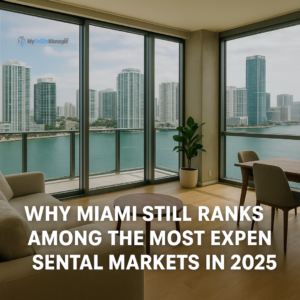For years, Miami has been synonymous with sunshine, beaches, nightlife and international flair but it has also become known for something far less glamorous: sky-high rents. And even as the U.S. rental market cools in early 2025, Miami continues to hold its place among the most expensive cities to rent a home.
According to new data published by Redfin and reported by CiberCuba, rental prices across the U.S. saw a slight decline to an average of $1,592 per month, the lowest since early 2022.
But Miami?
It remains in a class of its own.
Miami Rent vs. U.S. Average: A Huge Gap
While the national market cools, Miami’s rental prices have barely budged. The report shows:
-
Average rent in Miami (Dec 2024): $2,373/month
-
U.S. national average rent: $1,592/month
That means Miami renters are paying almost $800 more per month than the typical U.S. tenant.
But what makes this number even more alarming is the income required to afford it comfortably.
What You Need to Earn to Live in Miami
A renter should ideally spend only 30% of their gross income on housing.
To meet this guideline, Miami residents would need to earn:
$94,920 per year
But the average annual income in Miami?
Only $57,157
This creates a massive 40% affordability gap, making Miami one of the least affordable large cities in the country.
Why Is Miami Still So Expensive?
Several key factors keep Miami at the top of the national rent rankings, even when other metros see relief:
1. High Demand from New Residents
Miami continues to attract newcomers from out of state especially remote workers, investors, and retirees drawn by climate, taxes, and lifestyle.
Population demand remains stronger than the supply, pushing prices higher.
2. Investor-Driven Housing Market
A large portion of Miami’s condo and home inventory is owned by investors, not long-term residents.
Some units remain empty, used as vacation homes or Airbnb-style rentals.
Others are priced at premium rates.
This drives typical long-term rents upward, reducing availability for local families.
3. Limited Affordable Housing Development
New construction in Miami largely targets luxury segments, not workforce housing.
With few moderately priced units coming online, competition intensifies for anything under $2,000 which is now considered “affordable” by Miami standards.
4. A Slower-Than-Needed Drop in Rent Prices
While some areas in South Florida have seen slight rent decreases (about $200 in some parts), the reductions are not enough to help most residents overcome the affordability gap.
5. Wage Growth Hasn’t Kept Up
Even with Miami’s thriving tourism, service, and hospitality sectors, salaries have not risen at the same pace as housing costs leading to increasing financial stress on families and young professionals.
More Affordable Miami Neighborhoods (But Still Costly)
Although Miami remains expensive overall, the article highlights a few areas with historically more accessible rent options:
-
Riverview
-
Pinewood
-
West Little River
Past listings have shown one-bedrooms ranging from $672 to $1,020, but these prices are extremely rare by today’s standards and often snapped up instantly.
Affordable units exist but competition is fierce.
The Rise of Rental Scams in Miami
Demand has not only fueled high prices; it has also created a fertile environment for rental scams.
The report warns of increasing fraud schemes, including:
-
Fake listings for properties that do not exist
-
Scammers asking for advance deposits before property tours
-
Listings using stolen photos or addresses
-
“Owners” who suddenly disappear after receiving payment
How Renters Can Protect Themselves
- Avoid paying any deposit before seeing the unit
- Verify the property through county records or Google Maps
- Meet landlords or agents in person when possible
- Be cautious of listings priced far below market value
- If a Miami listing looks too good to be true, it probably is.
What This Means for Renters, Landlords, and Policymakers
For Renters
Budget carefully even middle-income earners may struggle.
Explore up-and-coming neighborhoods and consider roommates or shared rentals.
Be vigilant about scams.
For Landlords & Investors
Prices remain strong, but the widening affordability gap could reduce the pool of qualified renters.
Offering competitive prices or incentives could maintain occupancy in the long term.
For Policymakers
Miami’s housing crisis highlights deeper issues:
-
Stagnant wages
-
Limited workforce housing
-
Over-reliance on investor-owned units
-
Rising cost of living compared to average income
Addressing these gaps will be essential to keep Miami livable for its residents.
Final Thoughts
Miami is a vibrant, international, and fast-growing city but its red-hot rental market remains a challenge for many.
With demand high and wages lagging behind, affordability issues will continue to shape the city’s housing landscape in 2025 and beyond.
Anyone planning to rent in Miami should prepare for competitive pricing, limited availability, and the need for careful research to avoid scams.
Source
Read the full article here: https://en.cibercuba.com/noticias/2025-01-25-u1-e208933-s27061-nid296138-renta-eeuu-miami-sigue-siendo-ciudades-caras-2025

